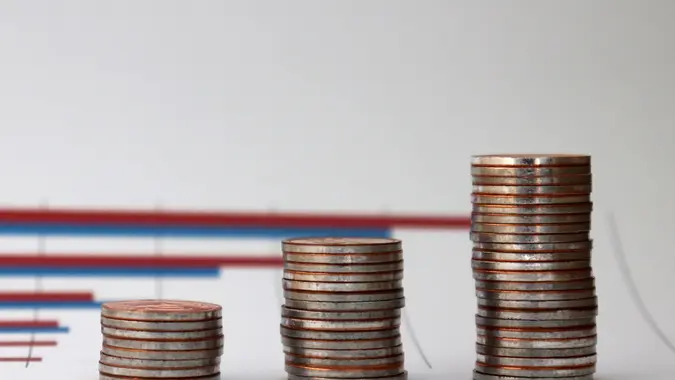How Big Is the Gap Between the Rich and the Poor in America?

Commitment to Our Readers
GOBankingRates' editorial team is committed to bringing you unbiased reviews and information. We use data-driven methodologies to evaluate financial products and services - our reviews and ratings are not influenced by advertisers. You can read more about our editorial guidelines and our products and services review methodology.

20 Years
Helping You Live Richer

Reviewed
by Experts

Trusted by
Millions of Readers
The gap between the rich and poor in America is huge and well-known. But what’s not very well known is just how large it is. According to the London School of Economics and Political Science, “The United States exhibits wider disparities of wealth between rich and poor than any other major developed nation.”
Even worse, that gap is growing.
Here’s a look at the state of wealth inequality in America and the consequences it has.
Wealth Inequality
Although income plays a role in building wealth, net worth is usually the factor people consider when speaking about the wealth gap. The net worth equation, according to Fidelity, is the sum of your total assets minus your total liabilities. To use a simple example, imagine that you have a home worth $400,000, savings and investments worth $100,000, a home mortgage of $250,000 and credit card debt of $10,000. In that case, your total assets are $500,000 ($400,000 + $100,000) and your total liabilities are $260,000 ($250,000 + $10,000). Subtracting your $260,000 in liabilities from your $500,000 in assets leaves you with a net worth of $240,000.
When focusing on net worth, the wealth gap in America is quite stark. According to the Federal Reserve Bank of St. Louis, as of Q1 2025, the top 1% of Americans controlled 30.8% of the country’s entire net worth. This is a significant increase over the Q3 1989 reading of 22.8%, the first year for which data is available, and brings America back to levels of wealth concentration seen during the 1920s. Broadening the scope a bit, the top 10% of Americans hold over two-thirds of the country’s wealth, according to the Center for Budget and Policy Priorities. Meanwhile, the bottom 50% holds less than 4% of the country’s net worth.
One interesting bit of information from the Federal Reserve data is how Americans hold their assets. Whereas most of the wealth of the bottom 90% of America is concentrated in real estate — typically, the family home — the upper class holds investments. Specifically, as of Q1 2025, the richest 1% of Americans held roughly 50% of all outstanding corporate stock and mutual fund shares.
Income Inequality
Although income itself doesn’t define the wealth gap, it’s an important contributing factor. Typically, higher income correlates with higher net worth, although this is not always the case. According to the U.S. Census Bureau, as of 2023, the most recent year for which data is available, the top 20% of Americans earned 51.9% of all income in the country. The top 5% alone earned 23% of all income. Meanwhile, the lowest 20% earned just 3.1% of aggregate income.
Growth Over Time
Perhaps not surprisingly, the adage that “the rich get richer” is definitely true in America, based on the data. According to data from the National Bureau of Economic Research, the net worth of America’s top 1% – and especially, the top 0.1% – has exploded over the past 30 years, while the net worth of the bottom 40% actually turned negative.
An analysis by the Urban Institute is particularly telling. According to its calculations, between 1963 and 2022:
- Families in the bottom 10% went from having $23 in debt to $450 in wealth;
- Those in the 50th percentile nearly quadrupled their wealth, from $50,598 to $192,700;
- Those near the top, in the 90th percentile, saw their wealth increase more than sixfold, from $294,573 to $1.9 million; and
- The wealthiest families — those wealthier than 99% of all families — saw their wealth increase more than sevenfold, from $1.8 million to $13.6 million.
While those at the bottom of the wealth scale saw a very small increase in net worth, those at the top saw their wealth explode, further expanding the gap. This is reflected anecdotally in other statistics. According to the Economic Policy Institute, for example, CEO compensation increased by more than 900% from 1978 to 2018, while worker compensation rose by just 11.9%.
Ramifications
Most Americans are at least anecdotally aware of the country’s wealth gap. But these statistics paint a clear picture of the exact dimensions of that gap, which is large and growing. The Wealth Inequality Initiative points out numerous consequences of this large disparity, including a negative impact on the economy and negative socio-political consequences, such as fewer worker protections and increased marginalization of certain groups.
More From GOBankingRates
 Written by
Written by  Edited by
Edited by 

























